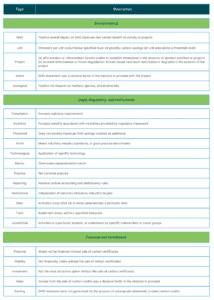scroll

The term Additionality is widely used in all carbon projects. The environmental integrity and quality of carbon credits from a project depend on additionality. So, what does additionality actually mean?
Additionality defined
Additionality, in the context of carbon credits, means that a carbon project must lead to emission reductions or removals that would not have happened without the project. The purpose is to identify and support projects that go beyond business-as-usual practices, encouraging investments in actual emission reduction or carbon removal activities. Ensuring additionality serves as a safeguard against projects that claim carbon credits for activities that would have taken place anyway, without any additional effort or intervention.
How to evaluate additionality of a project?
The process of determining additionality involves rigorous and detailed steps. Generally, carbon project developers or third-party verifiers compare the project scenario with the baseline scenario to determine additionality. Baseline scenarios are areas that continue business-as-usual practices but match the project area in most other attributes. Although these alternative, baseline scenarios are speculative, educated and scientifically supported predictions lend credibility and accuracy to project developers and third-party verifiers. Each carbon standard has its own tools and guidelines to predict what would have happened without the carbon project. All the standards, from Clean Development Mechanism (CDM) to Verified Carbon Standard (VCS) to Gold Standard (GS), consider various conditions pertinent to the project activity, such as investment and cost variables, barriers, and relevant regulations present at project development.
Additionality requirements
The concept of additionality is still a subject of significant controversy in carbon accounting and carbon markets. This controversy arises partly from difficulty of predicting alternate scenarios and the hypothetical nature of counterfactuals. There are at least five forms of environmental additionality, twelve forms of legal, regulatory, and institutional additionality, and five forms of financial and investment additionality that contribute to the complexity of assessing and establishing additionality. These are summarized in the table below.

Additionality at Boomitra
At Boomitra, we employ reliable tools and guidelines, following the Verified Carbon Standard (VCS) methodology, VM0042, and VCS standard requirements, to assess the additionality of our projects. We conduct thorough quality assurance and control checks along with due diligence for all activities within the project area. Boomitra seeks out advice from local experts in assessing the additionality of the project activities. To ensure compliance, we conduct a comprehensive desk review of existing laws in the project country to confirm that the selected project activity does not fall under mandatory requirements. As a multinational company, Boomitra performs an Environmental Impact Assessment (EIA) of the project activity as per the country law’s requirement. We document all barriers associated with the project activities extensively, drawing on published literature, and validate our findings through meaningful engagement with local stakeholders. The identification of relevant stakeholders is a collaborative process involving Boomitra and our local implementation partners. For each project, Boomitra deploys a comprehensive multi-level grievance resolution model to address any grievances raised by project stakeholders, such as partners or growers. Stakeholders have access to various channels, including email, telephone, and handwritten notes, to express their concerns and have them properly addressed.
Adhering to additionally standards is essential to ensure that carbon credits represent real, measurable, and additional emission reductions, thereby maintaining the integrity of carbon markets and promoting genuine climate action. Boomitra, as the leading soil carbon marketplace, is proud to uphold and surpass industry standards for additionality—serving as a model for high-integrity carbon offsets that are always additional.
To learn more about our carbon removal projects, contact us.



